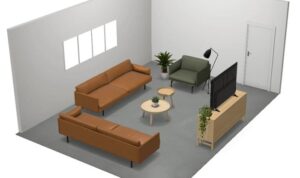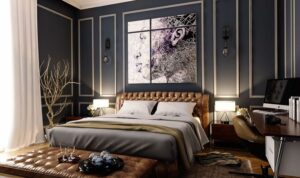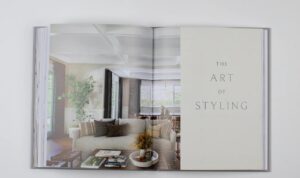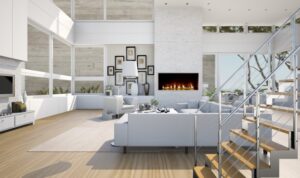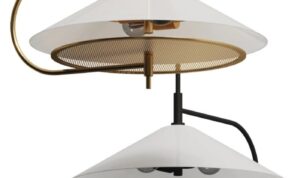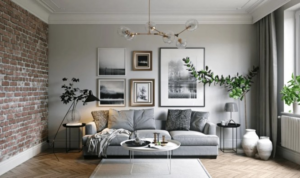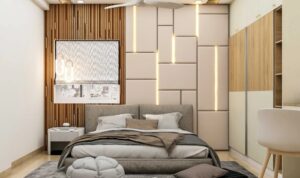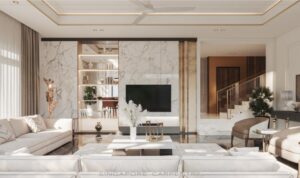Embark on a journey through the world of Bauhaus interior design, where innovation and creativity collide to define a unique aesthetic. Explore the key characteristics, historical significance, and modern influence of Bauhaus interiors in this captivating discussion.
Overview of Bauhaus Interior
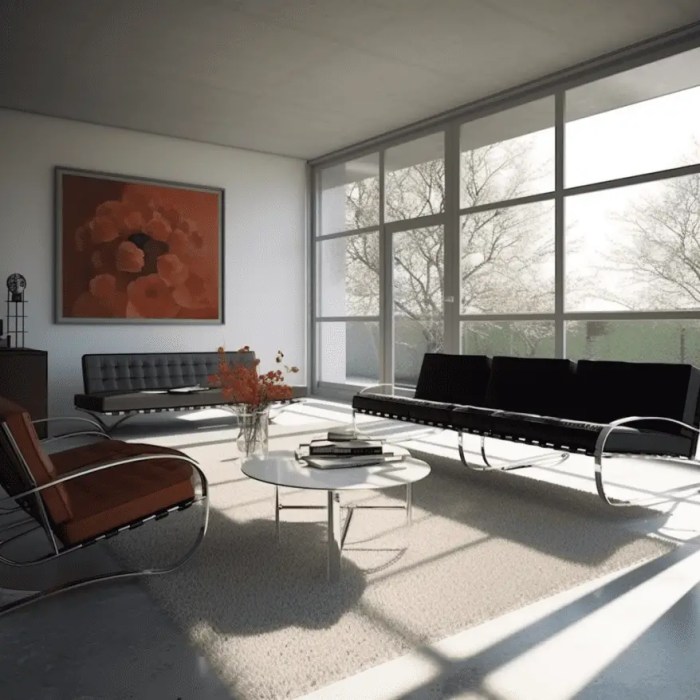
Bauhaus interior design is known for its minimalist and functional approach, focusing on simplicity, clean lines, and geometric shapes. It emerged in the early 20th century as a response to the industrial revolution, emphasizing the use of modern materials and techniques.
The historical significance of Bauhaus interior design lies in its revolutionary approach to merging art, craft, and technology. Founded by Walter Gropius in 1919 in Germany, Bauhaus aimed to create a new aesthetic for the modern age, blending form and function seamlessly.
Key Characteristics of Bauhaus Interior Design
- Minimalist approach with clean lines and simple shapes
- Emphasis on functionality and practicality
- Use of modern materials such as steel, glass, and concrete
- Integration of art and craftsmanship in design
- Neutral color palette with occasional pops of primary colors
Main Principles of Bauhaus Interior Style
- Form follows function - design should prioritize usability over ornamentation
- Unity of art and technology - combining artistic vision with industrial production
- Embrace of industrial materials - celebrating the aesthetic qualities of modern materials
- Simplicity and clarity - avoiding unnecessary decoration and focusing on essential elements
Influence of Bauhaus on Modern Interior Design
The Bauhaus movement has had a lasting impact on modern interior design, inspiring countless designers and architects around the world. Its principles of minimalism, functionality, and the unity of art and technology continue to influence contemporary interiors, creating spaces that are both aesthetically pleasing and practical.
Color Palette in Bauhaus Interiors
In Bauhaus interiors, color plays a crucial role in creating a harmonious and functional space that reflects the principles of the Bauhaus movement.
Typical Color Schemes
The color palette in Bauhaus interiors typically consists of primary colors such as red, blue, and yellow, along with neutrals like black, white, and grey. These colors are often used in bold blocks or geometric patterns to create a visually striking and balanced environment.
Importance of Color
Color is essential in Bauhaus interior design as it helps to define the functionality of a space, highlight architectural elements, and create a sense of unity and coherence. The use of primary colors adds a sense of vibrancy and energy to the interiors, reflecting the innovative and modern approach of the Bauhaus movement.
Utilization of Primary Colors
Primary colors are prominently featured in Bauhaus interiors, both individually and in combination. Red, blue, and yellow are used to add contrast, create focal points, and establish a sense of rhythm and balance within the space. These colors are often applied in their purest form, without shading or toning down, to maintain a sense of clarity and simplicity.
Evoke Bauhaus Style with Color
To evoke the Bauhaus style in interiors, one can use primary colors sparingly but strategically. For example, a pop of red in a predominantly white room can instantly inject a Bauhaus-inspired aesthetic. Additionally, using geometric shapes and patterns in primary colors can further enhance the modern and avant-garde feel of a space.
Furniture and Materials
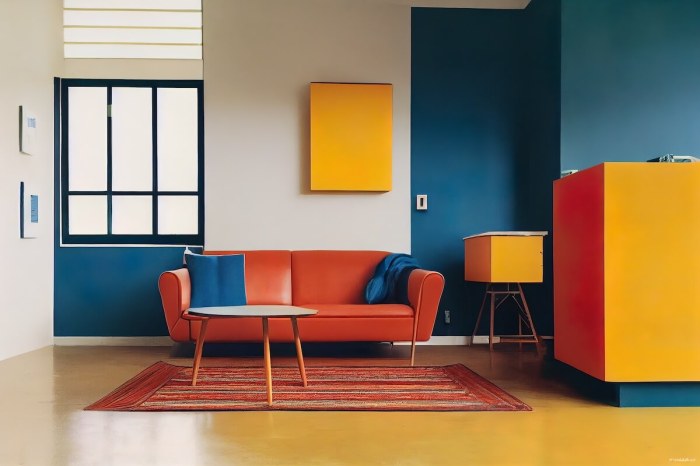
Bauhaus furniture and materials play a crucial role in defining the aesthetic and functional aspects of Bauhaus interiors. Let's delve into the common furniture pieces, materials used, the balance between functionality and aesthetics, and how Bauhaus designs have influenced modern furniture trends.
Common Furniture Pieces in Bauhaus Interiors
- Wassily Chair: Designed by Marcel Breuer, this iconic chair features a tubular steel frame and leather upholstery, embodying the Bauhaus principles of simplicity and functionality.
- Barcelona Chair: Created by Ludwig Mies van der Rohe, this sleek chair with leather cushions and a chrome frame is a timeless representation of Bauhaus elegance.
- Bauhaus Coffee Table: Characterized by clean lines and geometric shapes, Bauhaus coffee tables often combine glass, steel, and wood to create a harmonious blend of materials.
- Bauhaus Desk: Bauhaus desks are known for their minimalist design, featuring smooth surfaces, metal legs, and practical storage solutions, reflecting the emphasis on utility.
Materials Used in Bauhaus Furniture Design
- Steel: Bauhaus furniture typically incorporates steel frames for durability and a modern aesthetic.
- Leather: Leather upholstery is a common feature in Bauhaus furniture, adding a touch of luxury and sophistication.
- Glass: Transparent and reflective, glass is often used in Bauhaus furniture to create a sense of lightness and openness.
- Wood: While less prevalent, wood accents in Bauhaus furniture provide warmth and contrast to the sleek metal and glass elements.
Functionality vs. Aesthetics in Bauhaus Furniture
Bauhaus furniture design places a strong emphasis on balancing functionality with aesthetics. Each piece is thoughtfully crafted to serve a purpose while maintaining a visually pleasing appearance. The clean lines, geometric shapes, and minimal ornamentation prioritize utility without sacrificing beauty.
Influence of Bauhaus Furniture Designs on Contemporary Trends
The Bauhaus movement has had a profound impact on contemporary furniture trends, inspiring designers to embrace simplicity, clean lines, and the use of modern materials. Many modern furniture pieces pay homage to Bauhaus principles, blending form and function seamlessly in today's interiors.
Spatial Arrangement and Layout
In Bauhaus interior design, the emphasis is on open spaces and minimalism, creating a sense of harmony and functionality in the living environment. The spatial arrangement and layout play a crucial role in achieving the distinctive Bauhaus aesthetic.
Emphasis on Open Spaces
The Bauhaus movement values open, uncluttered spaces that allow for easy movement and flow within a room. This design principle aims to eliminate unnecessary elements and focus on essential furnishings to create a clean and unobtrusive environment.
Layout Principles
Bauhaus interior design follows principles of balance, symmetry, and geometric shapes in spatial arrangements. Furniture placement is carefully considered to maximize functionality while maintaining a visually pleasing and harmonious layout. For example, furniture is often arranged in a way that enhances the natural flow of the room and promotes a sense of openness.
Furniture Placement and Aesthetic Contribution
In Bauhaus interiors, furniture placement is not only about functionality but also about contributing to the overall aesthetic of the space. Pieces are often positioned strategically to create visual interest, emphasize geometric shapes, and highlight the craftsmanship of the furniture itself.
For instance, iconic Bauhaus pieces like the Wassily Chair or the Barcelona Chair are placed as focal points to showcase their design and form.
Comparison with Other Design Styles
When comparing spatial arrangement in Bauhaus interiors with other design styles like Victorian or Baroque, the contrast is stark. Bauhaus emphasizes simplicity, functionality, and minimalism, while traditional styles tend to feature ornate decorations, intricate patterns, and a more crowded layout.
The clean lines and open spaces of Bauhaus interiors create a sense of modernity and simplicity that sets it apart from more elaborate design styles.
Closing Summary
In conclusion, Bauhaus interior design continues to shape contemporary spaces with its emphasis on minimalism, functionality, and bold use of color. Dive into the Bauhaus style to elevate your living environment with a touch of timeless elegance.
FAQ Corner
What are the key characteristics of Bauhaus interior design?
Bauhaus interior design is characterized by simplicity, functionality, and the harmonious blend of form and function.
How did Bauhaus interior design influence modern interior design?
Bauhaus revolutionized modern interior design by emphasizing clean lines, geometric shapes, and the use of industrial materials.
What color schemes are typical in Bauhaus interiors?
Bauhaus interiors often feature primary colors like red, blue, and yellow, along with black, white, and grey to create a bold and dynamic palette.
What materials are commonly used in Bauhaus furniture design?
Bauhaus furniture design frequently incorporates materials such as steel, glass, and leather to achieve a sleek and modern look.
How does spatial arrangement play a role in Bauhaus interior design?
Spatial arrangement in Bauhaus interiors focuses on open spaces, minimalistic furniture placement, and a sense of airiness to create a harmonious environment.

